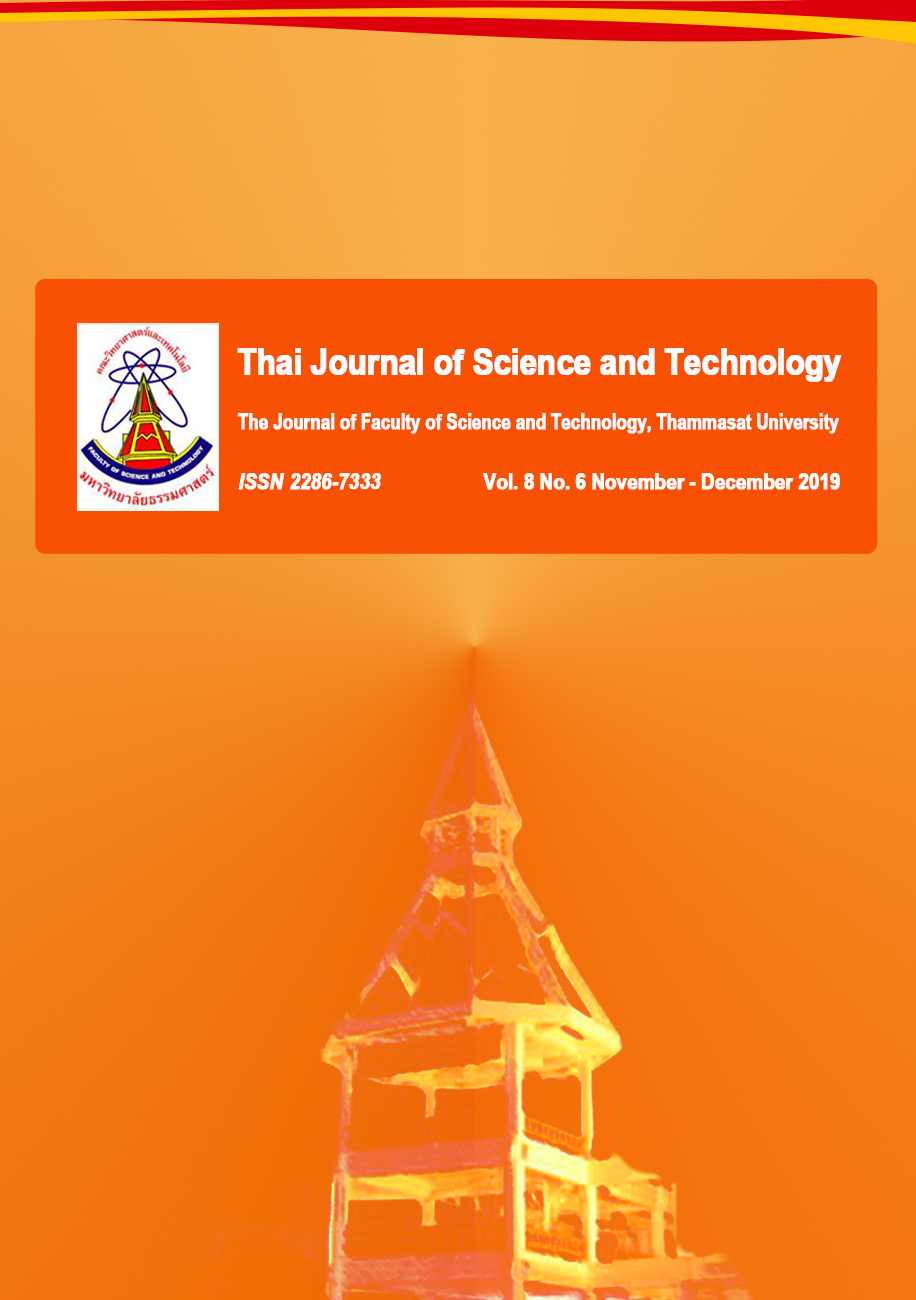การพัฒนาคุณค่าทางโภชนะของรำสกัดน้ำมันเพื่อเป็นอาหารสัตว์ด้วยยีสต์จากโรงงานผลิตเบียร์
Main Article Content
Abstract
Abstract
The objective of this study was to evaluate the nutritional value and digestibility of defatted rice bran fermented with Brewer’s yeast (BY) at 0, 10, 20 and 30 % for 0, 1, 2, 3 and 4 weeks. The result data concerning nutritional value showed that organic matter (OM) of defatted rice bran fermented with BY for 0-4 weeks was increased (p < 0.05), whereas dry matter (DM) and acid detergent fiber (ADF) of defatted rice bran fermented with BY for 0-4 weeks were decreased (p < 0.05). Defatted rice bran fermented with 30 % BY (2-3 weeks) had highest (p < 0.05) crude protein with the range of 25.03-25.42 % and defatted rice bran fermented with 30 % BY (1-2 weeks) had lowest (p < 0.05) neutral detergent fiber (NDF) with the range of 43.26-43.35 %. The ruminal digestibility (in vitro) of DM (56.97 %) and OM (55.36 %) of defatted rice bran fermented with 30 % BY at 4 weeks were high (p < 0.05). Furthermore, it was found that the DM digestibility in monogastric animal (in vitro) of defatted rice bran fermented with 30 % BY (3-4 weeks) and OM digestibility in monogastric animal of defatted rice bran fermented with 30 % BY (2-4 weeks) were highest (p < 0.05) with the range of 62.63-62.86 and 62.11-62.51 %, respectively. It was concluded that nutritional value of defatted rice bran was increased, whereas ruminal digestibility and digestibility in monogastric animal of defatted rice bran were maximized when fermented with BY at 30 % for 4 weeks.
Keywords: defatted rice bran; brewer’s yeast; nutritional value; digestibility
Article Details
บทความที่ได้รับการตีพิมพ์เป็นลิขสิทธิ์ของคณะวิทยาศาสตร์และเทคโนโลยี มหาวิทยาลัยธรรมศาสตร์ ข้อความที่ปรากฏในแต่ละเรื่องของวารสารเล่มนี้เป็นเพียงความเห็นส่วนตัวของผู้เขียน ไม่มีความเกี่ยวข้องกับคณะวิทยาศาสตร์และเทคโนโลยี หรือคณาจารย์ท่านอื่นในมหาวิทยาลัยธรรมศาสตร์ ผู้เขียนต้องยืนยันว่าความรับผิดชอบต่อทุกข้อความที่นำเสนอไว้ในบทความของตน หากมีข้อผิดพลาดหรือความไม่ถูกต้องใด ๆ
References
บรรจบ ไชยโยธา, 2542, การศึกษาการใช้รำสกัดน้ำมันและรำสตาบิไลซ์ ทดแทนรำละเอียดในอาหารไก่เนื้อและนกกระทา, วิทยานิพนธ์ปริญญาโท, มหาวิทยาลัยขอนแก่น, ขอนแก่น.
ปิ่น จันจุฬา และอัจฉรา เพ็งหนู, 2554, การผลิตและการใช้กากเนื้อในเมล็ดปาล์มน้ำมันเพิ่มโปรตีนโดยกระบวนการหมักด้วยเชื้อยีสต์เป็นอาหารสัตว์เคี้ยวเอื้อง, คณะทรัพยากรธรรมชาติ มหาวิทยาลัยสงขลานครินทร์, สงขลา, 39 น.
วลัยลักษณ์ แก้ววงษา, 2554, การใช้กากมันสำปะหลังหมักยีสต์แซคคาโรไมเซส เซรีวิซิเอ เป็นแหล่งโปรตีนสำหรับแพะเนื้อ, สาขาวิชาเทคโนโลยีการผลิตสัตว์ มหาวิทยาลัยเทคโนโลยีสุรนารี, นครราชสีมา, 126 น.
สินีนาฏ พลโยราช และเมธา วรรณพัฒน์, 2558, ศักยภาพในการใช้ยีสต์เป็นแหล่งโปรไบโอติกส์ในสัตว์เคี้ยวเอื้อง, แก่นเกษตร 43: 191-206.
สำนักวิจัยเศรษฐกิจการเกษตร, 2560, ข้าว, สถานการณ์สินค้าเกษตรที่สำคัญและแนวโน้มปี 2560, สำนักงานเศรษฐกิจการเกษตร, กระทรวงเกษตรและสหกรณ์, กรุงเทพฯ.
สิทธิศักดิ์ คำผา, อุทัย โคตรดก และสมมาศ อิฐรัตน์, 2553, การศึกษาการเพิ่มคุณค่ากากมันสำปะหลังหมักยีสต์-มาเลทและใบมันสำปะหลังเป็นแหล่งโปรตีนทดแทนกากถั่วเหลืองในอาหารข้นที่มีมันเส้นเป็นองค์ ประกอบระดับสูงต่อกระบวนการหมักในกระเพาะรูเมนและประสิทธิภาพการสังเคราะห์จุลินทรีย์โปรตีนในโคเนื้อ, มหาวิทยาลัยราชภัฏมหาสารคาม, มหาสารคาม, 102 น.
AOAC, 1990, Official Method of Analysis, 15th Ed., Association of Official Analytical Chemists, Arlington, Virginia.
Boisen, S., 1991, A Model for Feed Evaluation on In Vitro Digestible Dry Matter and Protein, pp. 135-145, In Fuller, M.F. (Ed.), In vitro Digest in Pigs and Poultry, Common Wealth Agriculture Bureaux International, Slough.
Goering, H.K. and van Soest, P.J., 1970, Forage Fiber Analysis (Apparatus, Reagents, Procedures and Some Applications), U.S. Government Printing Office, Washington, DC., 24 p.
Kamphayae, S., Kumagai, H., Angthong, W., Narmseelee, R. and Bureenok, S., 2017, Effects of different ratios and storage periods of liquid brewer’s yeast mixed with cassava pulp on chemical composition, fermentation quality and in vitro ruminal fermentation, Asian Australas. J. Anim. Sci. 30: 470-478.
Krochta, J.M., Baidwin, E.A. and Nisperos-Carriedo, M.O., 1994, Edible Coating and Film Improve Food Quality, Technomic Publishing Company, Inc., Pennsylvania, 379 p.
Raimbault, M., 1998, General and microbiological aspects of solid substrate fermentation, EJB Electron. J. Biotechnol. 1: 21-32.
SAS, 2004, STAT User’s Guide Release 9.1.3, SAS Inst., Inc., New York, 220 p.
Srichana, D., Suttitham, W., Thongsunthiah, P., Panja, P. and Jariyapamornkoon, N., 2014, Neutrients and ruminal digestibility of baby corn by-product silages under different harvesting medthods, Thammasat Int. J. Sci. Technol. 19(2): 30-36.
van Zyl, W.H., Lynd, L.R., den Haan, R. and McBride, J.E., 2007, Consolidated bioprocessing for bioethanol production using Saccharomyces cerevisiae, Adv. Biochem. Eng. Biotechnol. 108: 205-235.

